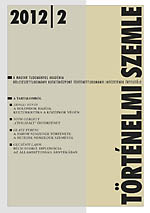A Három nemzedék története a hetedik nemzedék szemével
The History of the Három nemzedék from the Perspective of the Seventh Generation
Author(s): Ferenc GlatzSubject(s): History
Published by: Magyar Tudományos Akadémia Bölcsészettudományi Kutatóközpont Történettudományi Intézet
Summary/Abstract: Historical public opinion in Hungary in the interwar period was most influenced by the works of Gyula Szekfû, by the concise national histories written or edited by him, and by his reflections on history. His most popular work was the historical essay entitled Three Generations (Hung. Három nemzedék), which appeared in several consecutive editions between 1920 and 1934. Its first edition surveyed Hungarian history between 1840 and 1918, while that of 1934 took the story to 1933. The present study examines the ways in which the views of Szekfû about the development of capitalism in Hungary and the Hungarian middle classes had been formed, tries to answer the questions why he regarded the development betweeen 1867 and 1918 as a period of decline in 1920, and why he identified the Hungarian middle classes themselves, especially the traditional Christian petty nobility and the non-assimilated Jewish middle class as the very cause of the collapse of 1918. The basic conclusion of Szekfû’s national self-criticism was the necessity of a profound moral renewal. In the 1934 continuation of the book he listed the failures of the post-1918 Hungarian state: he urged for a new policy of social care lest the masses embrace the program of radicalism. Szekfû stood on the basis of modern conservativism, and rejected all new approaches in the direction of national socialism and fascism which were then being born in Europe. The author then surveys the basic theses set out in the works of Szekfû, and, while praising the ways in which he posed his questions, confronts Szekfû’s theses with his own on the problems of liberalism, the Trianon Peace Treaty, assimilation, decline and on the other major questions of Hungarian history between 1867 and 1988.
Journal: Történelmi Szemle
- Issue Year: 2012
- Issue No: 02
- Page Range: 247-277
- Page Count: 31
- Language: Hungarian

